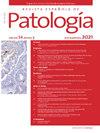腋窝结内栅栏性肌成纤维细胞瘤,罕见肿瘤,不寻常部位,文献回顾。
IF 0.5
Q4 Medicine
引用次数: 0
摘要
结内栅栏性肌纤维母细胞瘤(IPM)起源于腋窝,是一种极其罕见的良性间质肿瘤。它被认为起源于肌成纤维细胞或平滑肌细胞,并表现出特定的组织病理学特征。虽然偶有复发病例,但未见恶性转化。我们描述的情况下,一个35岁的男性表现为腋窝肿块。组织病理学显示肿瘤具有假包膜,包膜包含压缩淋巴组织,梭形细胞呈栅栏状排列,梭形细胞内有红细胞外渗。此外,还可见类淀粉纤维和嗜紫红体。免疫组化分析典型的SMA和cyclin D1阳性,低增殖指数(Ki67)本文章由计算机程序翻译,如有差异,请以英文原文为准。
Axillary intranodal palisaded myofibroblastoma, a rare tumour at an unusual site, with literature review
Intranodal palisaded myofibroblastoma (IPM) arising in the axilla is an extremely rare, benign mesenchymal tumour. It is believed to originate from myofibroblast or smooth muscle cells and exhibits specific histopathological features. While there have been occasional cases of recurrence, no malignant transformation has been observed. We describe the case of a 35-year-old male presenting with an axillary mass. Histopathology revealed a tumour with a pseudo-capsule that contains compressed lymphoid tissue with spindle cells arranged in a palisade-like pattern and extravasation of red blood cells within the spindle cells. Additionally, amianthoid fibres and fuchsinophilic bodies are present. Immunohistochemical analysis typically was positive for SMA and cyclin D1, with a low proliferative index (Ki67 of <1%). The diagnosis was intranodal palisading myofibroblastoma. Only two cases of IPM in the axilla have been previously reported. Pathologists should keep this rare entity with characteristic histopathological findings in mind when reporting such tumours at an unusual site.
求助全文
通过发布文献求助,成功后即可免费获取论文全文。
去求助
来源期刊

Revista Espanola de Patologia
Medicine-Pathology and Forensic Medicine
CiteScore
0.90
自引率
0.00%
发文量
53
审稿时长
34 days
 求助内容:
求助内容: 应助结果提醒方式:
应助结果提醒方式:


